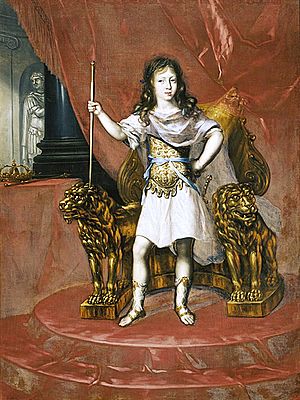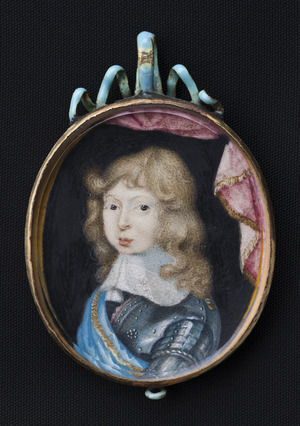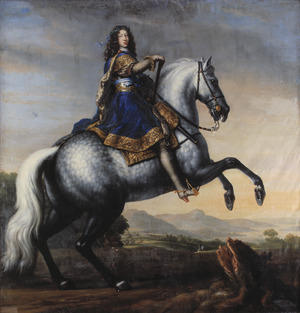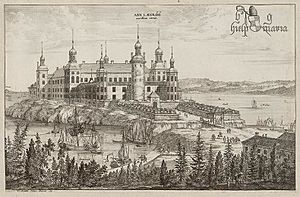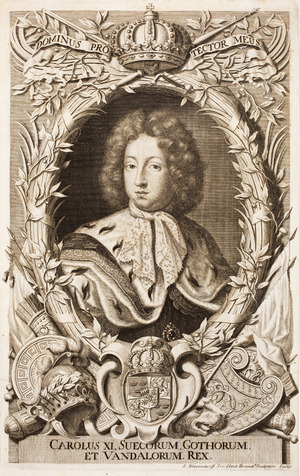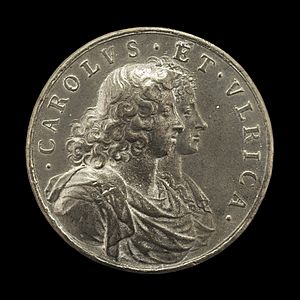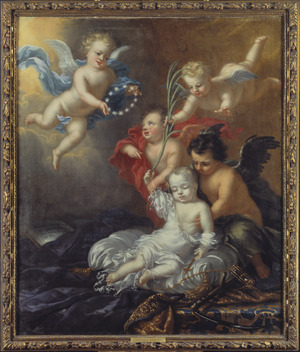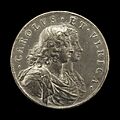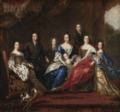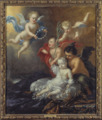Charles XI of Sweden facts for kids
Quick facts for kids Charles XI |
|
|---|---|
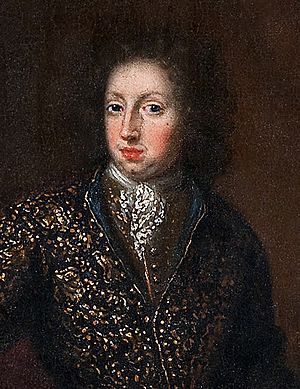
Portrait by Ehrenstrahl, c. 1691
|
|
| King of Sweden | |
| Reign | 13 February 1660 – 5 April 1697 |
| Coronation | 28 September 1675 |
| Predecessor | Charles X Gustav |
| Successor | Charles XII |
| Regent | Hedwig Eleonora of Holstein-Gottorp |
| Born | 24 November 1655 Tre Kronor, Sweden |
| Died | 5 April 1697 (aged 41) Tre Kronor, Sweden |
| Burial | 24 November 1697 Riddarholmen Church, Stockholm |
| Spouse | |
| Issue | Hedvig Sophia, Duchess of Holstein-Gottorp Charles XII Ulrika Eleonora, Queen of Sweden |
| House | Palatinate-Zweibrücken |
| Father | Charles X, King of Sweden |
| Mother | Hedwig Eleonora of Holstein-Gottorp |
| Religion | Lutheran |
| Signature |  |
Charles XI (born Karl XI; 1655–1697) was the King of Sweden from 1660 until his death. He ruled during a time known as the Swedish Empire (1611–1721).
Charles was the only son of King Charles X Gustav of Sweden and Hedwig Eleonora of Holstein-Gottorp. His father died when Charles was just four years old. This meant Charles was raised by special guardians until he became king at age seventeen.
Soon after becoming king, he had to lead his army in the Scanian War. This war was fought to protect lands Sweden had recently gained from Denmark. After winning against the Danes, Charles returned to Stockholm. He then worked hard to fix Sweden's money problems and improve its government.
Charles managed to keep Sweden peaceful for the next 20 years of his rule. During this time, he made big changes to the country's finances, trade, military, and education. His only son, Charles XII, became king after him. Charles XII used the strong army his father had built in many battles across Europe.
It's interesting that Charles was called Charles XI, even though he wasn't the 11th Swedish king named Charles. This numbering started because his great-grandfather, King Charles IX of Sweden (1604–1611), used a made-up history to choose his number. That ancestor was actually only the third King Charles. This numbering tradition continues today, with the current king of Sweden being Carl XVI Gustaf.
Contents
Becoming King: Charles XI's Early Life
Charles was born in November 1655 at the Stockholm Palace Tre Kronor. His father, Charles X of Sweden, had left Sweden to fight in a war against Poland. After years of fighting, the king came back in 1659. He met his four-year-old son for the first time in Gothenburg. Just a few weeks later, in January 1660, the king became sick and died.
Before he died, Charles X Gustav wrote a will. It said that his wife, Queen Dowager Hedwig Eleonora of Holstein-Gottorp, would lead the government while Charles XI was a child. She was the formal regent until Charles XI turned 17 in December 1672.
During his first meetings with the government, Charles was very shy. He would whisper his questions to his mother, and she would ask them aloud for him. As a teenager, Charles loved sports, exercise, and hunting bears. He seemed to struggle with reading and writing. Today, experts believe he might have had dyslexia, a learning difficulty that was not understood back then.
Many people at the time thought Charles was not well-educated. They believed he wasn't ready to handle important matters with other countries. He relied on his mother and advisors to talk with foreign visitors. This was because he didn't speak any foreign languages except German.
The Scanian War: A Young King's Challenge
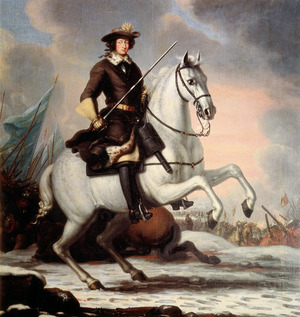
Europe was unstable, and Sweden faced money problems. In 1671, Charles XI's guardians made an alliance with France. This deal would protect Sweden if war broke out. It also brought money to Sweden from France.
In 1672, France attacked the Dutch. By 1674, Sweden had to send troops to help France. They marched towards Brandenburg under Karl Gustav Wrangel.
Denmark was an ally of the Holy Roman Empire. It became clear that Sweden and Denmark were heading for another war. To try and prevent this, a Swedish official went to Copenhagen in 1675. He tried to arrange for Charles to marry the Danish princess Ulrika Eleonora of Denmark. In June 1675, their engagement was announced.
However, when news arrived that Sweden had lost a battle, the Danish king declared war. This was the start of the Scanian War. The Swedish government was still fighting among themselves. The young King Charles, only 20 years old, had to lead without much help. He quickly prepared the Swedish army for battle in Scania.
The Danish army was larger and better equipped than the Swedes in Scania. In May 1676, the Danes invaded Scania. They captured cities like Landskrona and Helsingborg. Charles had to learn quickly and take charge.
His first success came at the Battle of Halmstad in August 1676. Charles and his commander defeated a Danish group. Charles then moved south through Scania. He reached the flooded Kävlinge River near Lund in November. The Danish army was on the other side.
Charles had to wait weeks for the river to freeze. On December 4, it finally froze. Charles launched a surprise attack on the Danish forces. This led to the Battle of Lund, one of the bloodiest battles of its time. About 8,000 soldiers died out of 20,000. Charles XI showed great bravery and fighting spirit. This battle was a turning point for Charles and for control of the Scanian lands. He remembered this date for the rest of his life.
The next year, Charles led 9,000 men to defeat 12,000 Danes at the Battle of Landskrona. This was the last major battle of the war. In 1679, the French king helped arrange a peace treaty. Charles XI was forced to agree to peace, but his Swedish Empire remained mostly intact. Peace was made with Denmark and Brandenburg.
Charles XI's Rule: Peace and Reforms
After the war, Charles spent the rest of his life avoiding more conflicts. He wanted Sweden to be more independent in its foreign policy. He also worked to improve the economy and reorganize the military. His last 20 years as king were the longest period of peace for the Swedish Empire.
Fixing Sweden's Finances
Sweden's economy was in bad shape after the war. In 1680, Charles called a meeting of the Riksdag of the Estates, which was like a parliament. Here, the king pushed through a major change called the "reduction." This meant that any land or property that had once belonged to the crown but was given away could be taken back.
This affected many rich noble families, and some lost everything. For example, a former guardian of Charles, Magnus De La Gardie, had to return the huge Läckö Castle. This "reduction" involved checking every property record in the kingdom. It completely reshaped Sweden's finances and made the country much stronger.
The Greycoat King
According to a Swedish legend, Charles XI would travel around the country dressed as a farmer. He was known as the Greycoat (Swedish: Gråkappan). He did this to find out if officials were corrupt or treating people unfairly. There are many stories about him visiting villages and punishing bad church leaders.
One story says he found a village with a beautiful church but a poor priest. In the next village, the church was falling apart, but the priest lived in luxury. The King solved this by switching the priests. He gave the poor priest the nice home, trusting he would fix the church. Charles traveled more than other kings of his time and was known for his fast journeys. These stories were published in a book in the 1800s.
Absolute Monarchy: The King's Power
Another important decision in 1680 concerned the Swedish Privy Council. Since 1634, kings had to take advice from this council. But during the Scanian War, the council members argued a lot, and Charles often ruled without them.
At the 1680 meeting, Charles asked if he still had to follow the council's advice. The Estates replied that he was "not bound by anyone other than himself." This officially made Sweden an absolute monarchy. This meant the king had complete power. In 1693, the Riksdag confirmed this, saying the king was the only ruler of Sweden.
Reforming the Military
In 1682, Charles proposed a new military plan. Each part of Sweden would have 1,200 soldiers ready at all times. Two farms would provide housing for one soldier. These soldiers were called Caroleans. They were trained to be skilled and to attack rather than defend. Stealing and violence were strictly forbidden.
The new system also included soldier huts built across the country. Charles also updated military techniques. He sent officers abroad to study and improve their skills.
The Swedish navy had suffered big losses in the Scanian War. This showed problems with its organization. So, Charles built a new naval base at Karlskrona in 1680. It became the main base for future naval operations. Today, Karlskrona is a UNESCO World Heritage Site.
Uniting New Territories
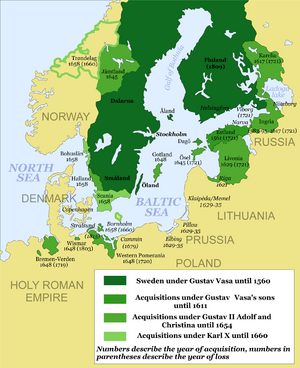
Charles believed it was important to make the new Swedish territories feel like part of Sweden. These included Scania, Blekinge, Halland, Bohuslän, Jämtland, and the island of Gotland.
Some of his policies included banning books written in Danish or Norwegian. He also made sure that sermons were given in Swedish. All new priests and teachers had to come from Sweden.
Charles was especially strict with Scania. During the Scanian War, local groups called Snapphane had attacked his soldiers. They also had strong support from the local people. Charles remained suspicious of the people in Scania. He didn't allow soldiers from Scania in his Scanian regiment. He also supported harsh treatment of the locals at first. However, later governors were more gentle.
The assimilation was not as strict in Sweden's German territories or the Baltic lands. In Germany, Charles faced opposition from local leaders. In the Baltic, the power structure was different, with German nobles who used serfs. Charles disliked serfdom and wanted to end it, but he couldn't.
Church Reforms
Charles was a very religious Lutheran Christian. In 1686, he introduced a new church law. This law stated that the king ruled the Church just as he ruled the country. Attending Sunday sermons became mandatory. People caught walking around during church time could be arrested.
Three years later, he made it required for everyone to learn a catechism. This was a book of religious teachings. He wanted people to understand "the magnificence of God." Charles also supported printing a new hymnal (completed 1693) and a new version of the Bible. The Bible was finished in 1703 and named after his son, the Charles XII Bible.
Charles XI's Family Life
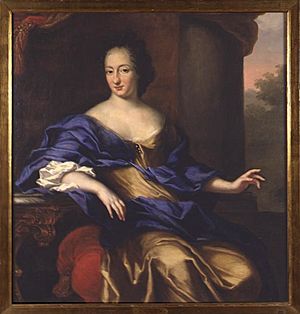
On May 6, 1680, Charles married Ulrika Eleonora of Denmark (1656–1693). She was the daughter of King Frederick III of Denmark. Their engagement in 1675 was meant to help end long-standing conflicts between Sweden and Denmark. However, the Scanian War soon broke out.
During the war, Ulrika Eleonora showed great kindness to Swedish prisoners. She even pawned her jewelry, including her engagement ring, to help care for them. Her good deeds made the Swedish people like her, despite her Danish background. The marriage was confirmed in 1679, and they married quickly in 1680. Charles put his government work before even his wedding ceremony.
Charles and Ulrika Eleonora were quite different. He loved hunting and riding, while she enjoyed reading and art. She is best remembered for her many charitable acts. She also had poor health and many pregnancies. Charles was very busy, and while he was away, she was often lonely.
However, their marriage was considered a success, and they were very fond of each other. As queen, Ulrika Eleonora had little political power. She was often in the shadow of Charles's mother. When the king took back lands from the nobility, Ulrika tried to speak up for those who lost property. But Charles told her he didn't marry her for political advice. Instead, she secretly helped people by giving them money from her own funds.
Charles XI's trust in her grew over time. In 1690, he named her as the future regent if his son became king while still a child. However, Ulrika Eleonora died almost four years before Charles. At the time of her death, she was personally supporting 17,000 people. It is said that on his deathbed, Charles XI told his mother he hadn't been happy since Ulrika Eleonora died.
Charles and Ulrika Eleonora had seven children. Only three of them lived longer than Charles:
- Hedwig Sophia (1681–1708), who became Duchess of Holstein-Gottorp.
- Charles XII (1682–1718), who became king after him.
- Ulrika Eleonora ("the younger", 1688–1741), who became queen after her brother.
Ulrika Eleonora (the elder) was often sick, and her many pregnancies made her health worse. When she became very ill in 1693, Charles finally spent all his time caring for her. Her death in July that year deeply affected him, and he never fully recovered. Their infant son Ulric (1684–1685) had a palace named after him, Ulriksdal Palace.
The Death of Charles XI

Charles XI had stomach pains starting in 1694. In the summer of 1696, the pain got worse, but his doctors couldn't find a cure. He continued to do his royal duties. However, in February 1697, the pain became too severe. He returned to Stockholm, where doctors found a large, hard lump in his stomach. At this point, doctors could only try to ease his pain. Charles XI died on April 5, 1697, at 41 years old.
Charles XI's Legacy

Charles XI is sometimes called one of Sweden's greatest kings. Some say he is second only to Gustavus II Adolphus. For a while, people thought he was weak and easily influenced. But in more recent books, he is seen as a strong leader. He made important economic reforms and brought financial and military stability to Sweden.
Charles XI's portrait was on the old 500-kronor bill. This is because the Bank of Sweden was founded in 1668, during his reign.
The fortified town of Carlsburg in Germany was named after Charles XI. The Swedish city of Karlskrona was also named after him. He built Karlskrona during his reign to be the main naval base in southern Sweden, and it still is today. Charles' Church in Tallinn, Estonia, is also dedicated to him.
Images for kids
-
Charles' coffin at Riddarholmen Church.
-
Image of King Carl XI on a wall of Stockholm Palace.
See also
 In Spanish: Carlos XI de Suecia para niños
In Spanish: Carlos XI de Suecia para niños


